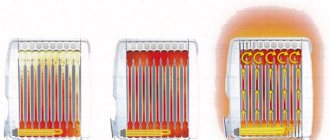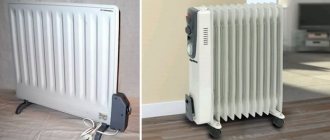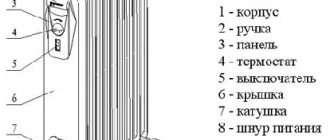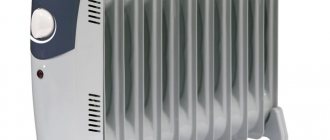When chilly autumn is replaced by frosty, sunny weather, everyone’s spirits immediately lift: from young to old. The joy is only darkened by the insufficiently comfortable temperature in the apartment or private house. There are two options: take warm, knitted socks, scarves and sweaters out of chests of drawers and closets, or run to the store for a heater. There are a lot of them on the shelves. For every taste and wallet thickness. We have already compared some types of heating devices with each other - you can see here and here. On these same pages we will arrange a competition between two more types of devices for heating residential premises and find out which is better, an electric convector or an oil heater.
Advantages and disadvantages
The oil radiator and electric convector have their strengths and weaknesses.
Convector
The choice of a convector can be influenced by its advantages and disadvantages.
- quick heating of the room, which is important for a summer house in winter;
- complete fire safety - the spirals are securely hidden in the housings of the heating elements or cool instantly (needle-shaped);
- safe during operation - the housing heats up to a maximum of +60oC. It is impossible to get burned. Therefore, it can be installed in children’s rooms if there are preschool children;
- the ability to create a modular heating system;
- economical operating mode due to the fact that temperature control sensors do not fall into the heating zone;
- are not afraid of direct contact with water and high humidity - can be installed in bathrooms (except for needle type);
- compactness - takes up little space, especially when hanging on the wall;
- “Maslyanika” fits better into the interior design.
- a heater with a ceiling height of more than 3 m is practically useless due to the formation of a stagnant zone with a high temperature in the ceiling space, i.e. The ceiling is actively heated, not the room. The reason is simple: convection currents do not have enough kinetic energy to draw all the air masses into circulation. The same applies to large premises;
- dries the air;
- actively raises dust - you will have to spend a little more time cleaning;
- creates unpleasant drafts at floor level;
- rapid temperature drop when switched off;
- when mounted on a wall, there is a large temperature difference between the floor and the ceiling - up to 10oC, which contradicts the recommendations to keep your head cold and your feet warm.
Oil heater
The popularity of this type of device is due to its advantages.
- simple design;
- large heat transfer surface area due to the ribbed housing;
- affordable price (if there are no bells and whistles, some of which are needed just because) - you can always choose a device that suits your financial capabilities;
- long period of operation;
- silent operation, unless there is a built-in fan - the case does not crackle when heating and cooling;
- the housing and oil accumulate a large amount of heat, which allows you to maintain a comfortable temperature in the room for a long time after turning off the device;
- mobility - despite the weight, it is quite easy to move from room to room (many devices are equipped with wheels);
- easy to connect;
- you can choose models with many additional functions, including an air humidifier;
- There are designs with the possibility of installation on the floor and wall;
- The combined heating principle avoids strong air currents caused by the convection method of heat transfer. No drafts - little dust in the air;
- there are no odors when turning on and working;
- high level of reliability - the device can work continuously for days.
- higher level of electricity consumption per hour compared to other heating devices (due to high power);
- It takes a long time to warm up itself, and, consequently, heats the room. But this is the other side of the coin: then it gives off heat for a long time, and this is a definite plus;
- dries the air - some manufacturers solved the problem by using a humidifier built into the heater;
- The temperature sensor built into the housing does not work entirely correctly - the readings are affected by the heater itself. But this does not affect the efficiency of the device. It’s just that during the first hours of operation of the oiler, it will turn off a little earlier than necessary. “Tricky” programming of the climate control will help. First, the temperature is set higher than necessary, and then lowered by a couple of degrees;
- the significant dimensions of the “butter pan” eat up the usable area of the room;
- despite the varied design, the devices hardly fit into the interior;
- overheating of the housing can cause a fire, which has already been observed several times - the oil that broke out ignited;
- The scourge of the device is microcracks in welding. Cannot be repaired. The device is quickly taken out of service. They cause fire. They can form in any model, regardless of brand. True, for some manufacturers they appear extremely rarely, for others a little more often. It is impossible to talk about the widespread nature of the problem, but sometimes you should look to see if streaks have appeared. The smell of evaporating oil also indicates a malfunction.
The result of an oil leak.
We cannot agree with a number of negative characteristics.
- Low efficiency due to the fact that part of the heat is spent on heating the housing and oil. This does not take into account the fact that the heat does not go outside the room, but remains in it - after turning off, the heater cools down and heats the environment for a long time. There are no losses, which means it is incorrect to talk about low efficiency.
- High (25%) energy consumption compared to other types and types of heaters. Again, the fact that the efficiency of using electricity of all heating elements is the same is not taken into account - 97-98%. Here we can only say that due to high power, losses in indoor wiring increase. But they can't be as big as they say. Maximum - 3-4%.
- Uneven heating. Firstly, this disadvantage is inherent in all convection and combined appliances. Secondly, infrared radiation is not taken into account, which allows the room to be heated more evenly compared to a central heating battery. Thirdly, nothing prevents you from installing the device in the middle of the room during operation, guaranteeing the same temperature around the perimeter of the room.
The above advantages and disadvantages allow us to draw the first conclusions which is better, a convector or an oil radiator. However, such information is not enough for an informed choice. Therefore, we will conduct a comparative analysis.
Electric convectors
The body of such heaters is almost always flat and smooth, which is what actually distinguishes it from oil heaters. If the latter are in most cases placed on the floor and rarely attached to the wall, then in the case of electric convectors there are no restrictions. They are completely silent and very comfortable. If necessary, you can attach it to the wall, and if necessary, remove it and install it on legs.
You are probably familiar with the operating principle of an electric convector. It consists in the fact that cold air enters it and hot air comes out. As a result, heated air rises, while cold air remains below. If everything works properly, then convection flows are established, which ensures the optimal temperature in the room. Well, now let's go further and look at something else interesting.
Comparison of characteristics
To buy a really cool heater, you need to compare its technical and operational characteristics with alternative offers. In our case, we will compare the oil tank and the convector according to the following criteria:
- cost is the most important indicator. The incomes of most Russians are such that they first of all pay attention to the difference in price;
- durability is an important indicator, but often ignored due to the low cost of the device you like. After all, a heater is needed here and now, but there is no money for an expensive but durable purchase;
- coefficient of performance (efficiency) - according to an established tradition, consumers are always looking for information on how efficiently heating devices use electricity. Nobody wants to overpay for its consumption. Manufacturers also support this interest, describing how economically their product works;
- room heating rate. The criterion for a residential building and apartment is of little significance: it has basic heating. But for a dacha or garage - the most important;
- ease of use. When buying any electrical appliance, you always want one thing: plug it in and forget about its existence;
- design - there is only one desire: for the newly acquired item to fit well into the interior. Therefore, consumers sometimes spend a long time selecting a heater based on design, ignoring other characteristics or relegating them to the background;
- safety. No less important indicator. Particular attention should be paid to it with small children in the family;
- availability of additional functions. Little attention is paid to this criterion, but in vain.
Which is cheaper?
The range of prices for “oil tank” and convector is enormous. For example, an oil radiator with a power of 0.5 kW can be purchased for 1,699 rubles. And next to it is three times more powerful for almost the same price - 1990 rubles. The same situation applies to convectors. But in general, oil pans are about 30-40% cheaper.
Conclusion: you will have to pay a lot of money for a convector.
What will last longer
The best indication of actual service life is the warranty period. After all, they are always 2-3 times less than the actual operating time. Let's compare:
- oil battery - warranty period 1-2 years, actual service life from 5 to 7 years. True, there are also long-livers: with several replacements, the heating element lasts more than 15 years and does not go to landfill;
- convector - warranty period is 5-10 years, actual service life is 15-20 years.
Conclusion: in terms of durability, the convector is the leader by a wide margin - there is simply nothing to break, and a burnt-out heating element can be replaced.
What is more effective
There is a myth circulating among sellers and specialists that the convector is economical. Its electricity consumption is approximately 25% lower. If you carefully read school textbooks on physics, you will find out, and scientific publications confirm, that for all heating elements, without exception, the efficiency of electricity use is in the region of 98-99% (losses are attributed to the resistance of indoor wiring). Our devices are no exception.
To be fair, we note that the myth was not born out of nowhere: prolonged heating of the oil and housing was considered a loss of electricity. But they did not take into account that after switching off, the accumulated heat is given back for a long time, while the convector cools down almost immediately.
But there are other factors when assessing effectiveness that are not considered at all. One of them concerns the installation location of the heater: the higher it is, the lower the output: the ceiling is heated. And this directly applies to convectors: most of the models are wall-mounted. The second has to do with the height of the room. With a ceiling higher than 3 m, the oil pan will heat in standard mode; there is practically no benefit from the convector: a well-heated “dead zone” is formed at the top, which is not captured by convection currents.
Conclusion: an oil heater is still more efficient.
Which heats up faster?
The convector begins releasing heat to the air masses in the room almost immediately after switching on. Therefore, it heats the room faster. The oil radiator and built-in fan heater do not help. The warming up process increases sharply, but is still slightly inferior in time to its competitor due to prolonged heating.
Conclusion: according to the analyzed indicator, the convector is the best.
Which is more convenient to use?
If you have electronics, connect the oiler to the power supply, set it up and enjoy. A little different with convectors. There are two problems here:
- the rise of a huge amount of dust into the air, which likes to settle in places hard to reach for cleaning - you have to wipe shelves, chandeliers, lamps, etc. more often;
- crackling of the tubular heating element. You quickly get used to it, but it’s still unpleasant.
The oil-based device does not have problems with dust due to weak air flows.
Conclusion: the oil battery does not create problems during operation. She has the advantage.
The result of the convector operation.
Design
It has been rightly noted that “there is no comrade according to taste.” Therefore, we will not evaluate the design of the devices being compared - everyone has their own tastes and preferences. Let us refer to reviews left by consumers on various forums, where an interesting situation has arisen.
By all accounts, free-standing oil heaters have an advantage over convectors - they look much nicer. But it’s difficult or impossible to fit the handsome guy into the design of the rooms - they look like a foreign body.
The design is good, but how to fit such a device into the interior.
Conclusion: It is difficult to judge whether a convection heater or an oil radiator has a better design. Still, we’ll give a slight advantage to the flat convector - it looks more harmonious in the apartment, especially on the wall.
Safety
Both devices are almost equally “stuffed” with security systems. There is a shaky but parity here. However, there are a few things.
- When oil reaches a certain temperature, it does not boil, but ignites, even in hermetically sealed containers. The result is an explosion and fire. Therefore, it is extremely important not to dry any items directly on the oil device, preventing the sections from overheating. For such purposes, there are various shelves that are hung on the battery case.
- The convector body temperature does not exceed +60oC. The situation is approximately the same with competitor models with a protective casing. If it is not there, then the risk of getting burned tends to 100% - the body sometimes heats up to +100oC;
- Convectors with tubular and solid heating elements can be installed in the bathroom without fear. There are no oil devices. The reason is the risk of microcracks forming on the body when water enters. The welding seam is especially dangerous.
- A working oil pan should not be left unattended for long periods of time. The leaking oil from the formed microcracks burns beautifully, as more than a dozen families have been convinced of.
Conclusion: despite almost identical safety systems, the convector has a rather significant advantage.
Additional functions
In both heaters you can find additional features:
- electronic control;
- different operating modes;
- built-in ionizer;
- humidifier.
All this is good. But the “oiler” has something that the convector does not have - quick drying of clothes and shoes. The convector also has similar attachments, but it dries much slower - the body temperature is lower.
It is believed that it is impossible to dry things on a convector. The photo refutes this point of view.
Conclusion: in situations where you need to quickly dry things, an oil radiator is in the lead.
Summary comparison table
For clarity, we summarize the above analysis in a table.
Table 1. Comparative characteristics of the converter heater and oil radiator expressed in numbers.
| Characteristics | Convector | Oil heater |
| Price | 4 | 5 |
| Life time | 5 | 3 |
| Efficiency | 4.5 | 5 |
| Room heating speed | 5 | 4 |
| Ease of use | 4.5 | 5 |
| Design | 4.5 | 3.5 |
| Safety | 5 | 4 |
| Additional functions | 4.5 | 5 |
| average rating | 4.63 | 4.31 |
The table provided, although not 100% objective, allows you to give a hint when answering the question: a convector heater or an oil heater, which is better to choose. Naturally, preferences may differ. But there are situations when the choice is obvious.
Oil heater
Installing the unit and using it is quite simple; it is necessary to ensure uninterrupted power supply from the mains. Due to the long wire, you can move the device to the desired place, which most needs additional heating. Breakdowns are unlikely, this is due to the simplicity of the design, so the units are used quite often.
Principle of operation
Mineral oil is poured into the high-quality steel radiator at the factory; the reservoir is equipped with a heating element that helps heat the liquid.
Often the package includes a rheostat so that temperature adjustment does not cause inconvenience. There is also a compartment in which protective devices are installed; they protect the user from short circuits caused by overheating.
Advantages and disadvantages
The devices are cheap, which makes them very popular among different segments of the population; the process can be safely called quiet. Due to its low noise level, the equipment can be left in working order throughout the night and does not interfere with rest. Ease of movement is also worth considering when deciding whether to choose an oil heater or a convector.
The unit can easily be moved to any room in an apartment or private house; for power, it is enough to allocate a free socket with a current supply of 220 V. The housing can get very hot, and this, if not done carefully, will lead to burns; the device itself is quite heavy.
What is better to choose and in what case
The advantages of a convector are obvious, but the oil pan is better suited for the office. It is also purchased when there is a limited budget or the need for uniform heating. You can’t do without it in the garage either—extra dust doesn’t belong there. The device also fits well into the heating system of an apartment or house if additional heating is needed while the main heating is constantly running.
In other cases, a convector is preferable, especially at the dacha, where quick heating of the room is needed. Recommendations are not the ultimate truth - the choice in any case falls on the shoulders of the consumer.











